By Daniel H. Mutibwa, Brian Kennedy, Amanda Hanton, and Suzie Parr
Working towards communicating effectively what Culture Leicestershire is and what it does
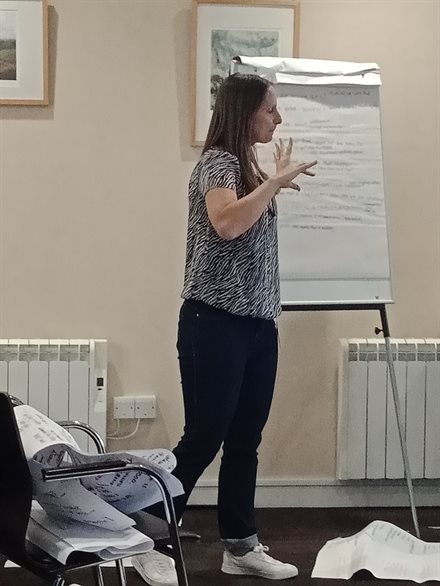 Beckie Smith facilitating the session
Beckie Smith facilitating the session
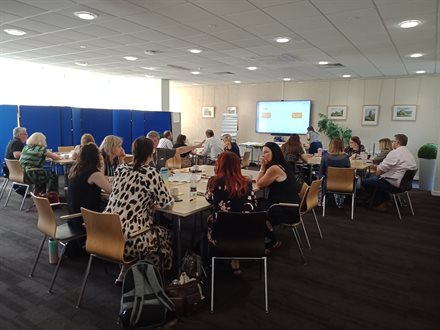 CuL Staff Teams in attendance at the session
CuL Staff Teams in attendance at the session
These are extremely busy but exciting times at Culture Leicestershire (CuL) - also interchangeably referred to as Libraries, Heritage, Collections and Learning and Cultural Participation Services - at Leicestershire County Council (LCC). On Monday 24th June 2024, an all-day event titled ‘Thinking Big Workshop: Culture Leicestershire’ was held at County Hall. CuL staff teams from (1) the Collections and Creative Learning Services (CLS) and Record Office, (2) Cultural Participation, (3) Heritage, and (4) Libraries attended the workshop which was facilitated by Beckie Smith (Director, Flying Geese - an arts, culture and heritage consultancy).
 Beckie circulating flipchart paper in preparation for small-group discussion
Beckie circulating flipchart paper in preparation for small-group discussion
Flying Geese has been commissioned by LCC to support development of an audience data strategy that clearly and confidently tells the story of what CuL is, what CuL does, and how CuL improves and enriches the lives of the many audiences and local communities it serves.
This development work is aimed at producing a consistent and coherent suite of data processing approaches that works for CuL’s diverse service areas.
Building on data methodologies already in use, the work is generating robust mechanisms for collecting, analysing, reporting, and acting on insightful data.
It is within this context that the ‘Thinking Big Workshop’ took place.
‘Theory of Change’: Transitioning from circumstances in ‘the now’ to those in ‘the future’
 Staff Teams receiving task-related instructions
Staff Teams receiving task-related instructions
Following introductory words from Franne Wills (Head of Service), Beckie provided an overview of how she planned to walk us through the day’s activities. The workshop agenda was packed with a rich mix of warm-up activities, lecture-style delivery, tasks, small-group discussion, and plenary sessions.
Comfort breaks were built in at designated points. The introductory, warm-up task, for example, required us to choose one of two options.
Using a pen and a sheet of paper, staff were asked to draw either a 20p piece or the first page of apps on their smartphones. The purpose of this task was simple yet telling; it can sometimes be hard to articulate the routine things that we interact with in our everyday, personal lives or in our professional work environments - when specifically asked to do so by others.
In other words, when we become overly familiar with certain things - there is always a risk we may take those ordinary things for granted.
When this happens, we may fail to appreciate those routine things properly. We may also lose curiosity for them by failing to question them. Discussion then moved on to the ‘theory of change’ which can be understood as a way of describing one’s journey or an organisation’s journey from one point to another. That journey encompasses current circumstances (‘the now’) and what might need to happen to change those circumstances later (‘the future’).
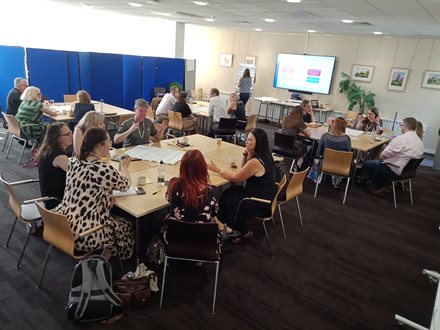 Small-group discussion in progress amongst staff teams
Small-group discussion in progress amongst staff teams
Beckie invited staff to think about the ‘theory of change’ by asking the following two questions. In ‘the now’, so went the first question, ‘what are the really big problems that we would just LOVE to solve?’ In ‘the future’, the second question asked, ‘what does life look like once these really big problems are solved?’
At a more general level, one big problem that humanity would love to solve in ‘the now’ would be the unfair division of food in the world. Solving this major problem would mean that many more people in the world would have enough food in ‘the future’.
At a more specific level relating to CuL, one big problem in ‘the now’ is that ‘some people do not think that museums are “for them”’.
Tackling this problem would result in many more people ‘engag[ing] with museums and heritage as part of their daily life’ in ‘the future’. We learnt that the transition from circumstances in ‘the now’ to those in ‘the future’ is driven by four important questions. In CuL’s context, these could be framed and posed as follows:
- who is affected by the problem of non-engagement with museums and heritage owing to the perception held by some that museums are not ‘for them’?
- what are CuL teams doing to solve this problem?
- how does CuL want people to experience the change when it happens?
- what makes CuL great at enabling people to experience the change positively?
The ‘mechanism of change’: When the ‘yeast is heated’
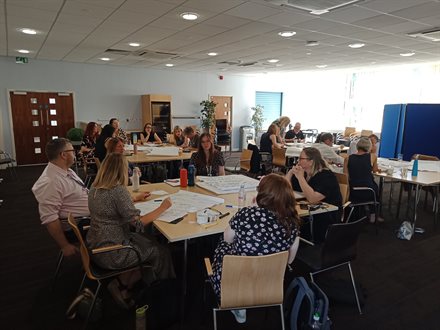 First image of small-group discussion in progress amongst the Libraries Staff Team
First image of small-group discussion in progress amongst the Libraries Staff Team
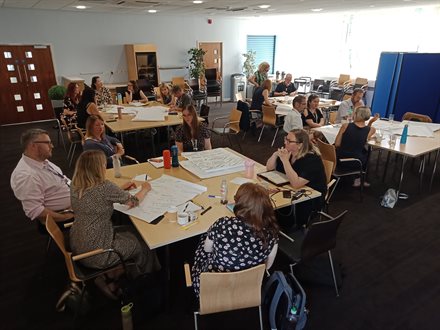 Second image of small-group discussion in progress amongst the Libraries Staff Team
Second image of small-group discussion in progress amongst the Libraries Staff Team
The process of transition, we learnt, is called the ‘mechanism of change’. This can be understood as the factors that cause the change and the way that change happens. Returning to the big problem of non-engagement with museums and heritage due to unfavourable perceptions, the ‘mechanism of change’ can be impelled by four guiding questions:
- How does CuL want people to engage with the activities of its museums?
- What kind of relationship does CuL want to establish with people?
- How does CuL want those people to feel?
- What thought process(es) does CuL want them to experience?
Although museums and heritage are mentioned here specifically, the logic applies to CuL’s other assets such as libraries and other cultural venues. To illustrate the ‘mechanism of change’ in action, Beckie deftly used the analogy of baking bread. In ‘the now’, one collects the necessary ingredients: (1) yeast, (2) warm water, (3) salt, (4) flour, and (5) sugar. These are mixed and heated to make bread in ‘the future’. The point at which the yeast and/or entire mixture is heated is the ‘mechanism of change’.
Leveraging the ‘mechanism of change’ to enhance audience engagement through a data-led and flexible approach
 Small-group discussion in progress amongst the Collections and Creative Learning Services Staff Team
Small-group discussion in progress amongst the Collections and Creative Learning Services Staff Team
 Small-group discussion in progress amongst the Heritage Staff Team
Small-group discussion in progress amongst the Heritage Staff Team
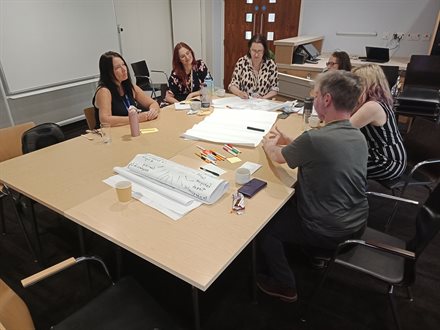 First image of small-group discussion in progress amongst the Cultural Participation Staff Team
First image of small-group discussion in progress amongst the Cultural Participation Staff Team
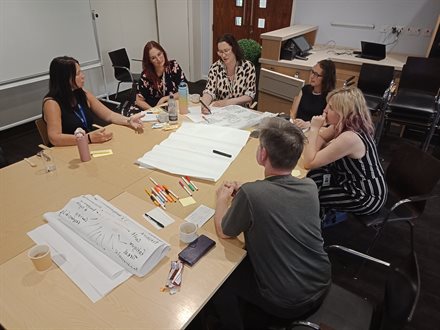 Second image of small-group discussion in progress amongst the Cultural Participation Staff Team
Second image of small-group discussion in progress amongst the Cultural Participation Staff Team
Within the teams listed at the start of this post, staff were asked to discuss the following. First, the big problems they would want to solve. Second, what life looks like because of people experiencing those problems. Following small-group discussion, staff were invited to share in the first plenary session.
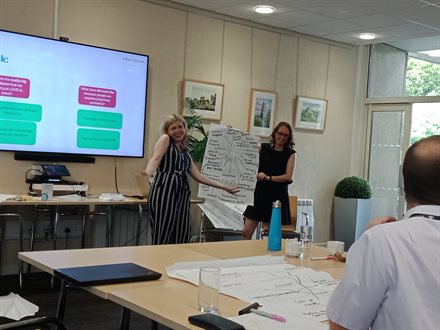 Cultural Participation Staff Team reporting back during the first plenary session
Cultural Participation Staff Team reporting back during the first plenary session
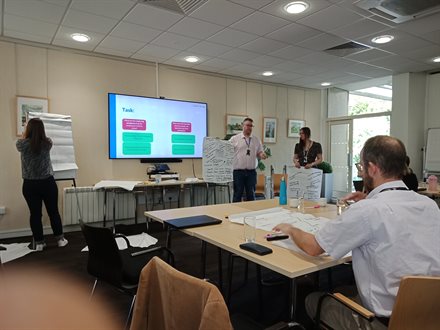 Libraries Staff Team reporting back during the first plenary session
Libraries Staff Team reporting back during the first plenary session
Although the teams work in different (though overlapping) service areas, the common problems identified revolved around:
- socio-economic challenges which have been aggravated by the cost-of-living crisis;
- changing demographics in communities;
- a lack of digital access;
- transport barriers;
- time constraints;
- a general perception of not being listened to; and
- stiff competition for limited budgets.
As a result of these problems, people have:
- disengaged because they do not feel represented in culture in particular, and society in general;
- lost trust in authorities and public services which has led to apathy;
- felt socially excluded, trapped, and pressured as well as lost confidence in expressing themselves; and
- prioritised what they see as the most important, immediate needs - just to be able to survive.
Overall, the team contributions highlighted the key fact that this state of affairs was not helped by the persistent austere environment and politically uncertain climate characterising current times.
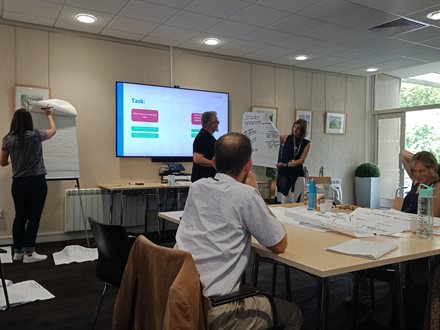 Collections and Creative and Learning Services Staff Team reporting back during the second plenary session
Collections and Creative and Learning Services Staff Team reporting back during the second plenary session
Staff were then asked to consider the following two questions in their further small-group discussion. First, what are staff teams doing to contribute to solving these problems? Second, how do staff teams want people to experience this? Tackling these questions embodies the ‘mechanism of change’ in action. We learnt that there is ‘no textbook way of doing this’. Following discussion, common staff team contributions to solutions included:
- working hard to be perceived as a trusted source - and even a reliable partner, to ensure that people feel included in culture, and to build legacy in inclusive ways that create positive memories for people;
- being respectful and responsive;
- supporting other teams and units to achieve shared outcomes;
- signposting effectively;
- developing bespoke approaches to engagement;
- being data-led, using profiling better, and continually evaluating, reviewing, and upskilling; and
- bolstering the co-creation approach to service delivery and partnership working.
 Heritage Staff Team reporting back during the second plenary session
Heritage Staff Team reporting back during the second plenary session
Staff teams want people to experience this in these ways.
First, that people find the solutions meaningful to them, that people feel value for money and recognise that public funds are being spent wisely, and that people feel confident, heard, proud, seen, supported, valued, and welcomed.
Second, that people engage much more, connect with one another - especially in communities and places with new builds, and have fun via both in-person engagement and hybrid format.
Third, that people recognise CuL’s shift away from a transactional relationship and/or approach to a more flexible one in which people are encouraged to say what they want or do not want, and to explore and be curious.
The value of understanding the different motivations driving engagement with museum and heritage experiences
 Collections and Creative Learning Services Staff Team in small-group discussion between plenary sessions
Collections and Creative Learning Services Staff Team in small-group discussion between plenary sessions
Following two breaks and some further discussion in-between, staff teams were asked to reflect on who precisely is affected by the big problems discussed, and who exactly their work was aimed at.
The constituencies named across staff teams as being affected by the big problems included:
- families;
- young people;
- children with special needs;
- people with low incomes;
- elderly people;
- people with access needs;
- communities of British nationals new to Leicestershire; and
- people from migrant communities and minority faith groups.
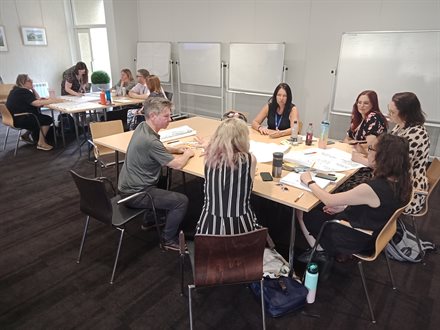 Small-group discussion in progress. The Cultural Participation Staff Team is shown at the front, and the Libraries Staff Team, in the background
Small-group discussion in progress. The Cultural Participation Staff Team is shown at the front, and the Libraries Staff Team, in the background
The ideal is to target as many people from these constituencies as possible meaning CuL’s offerings need to have something for everybody.
Discussion shifted to the kinds of people who are known to visit museums (although it is worth noting that the insights here can very well be extrapolated to CuL’s other cultural assets and sites).
It is here that Beckie alluded to seminal research that explored types of museum visitors and how their identities affect their museum experience.
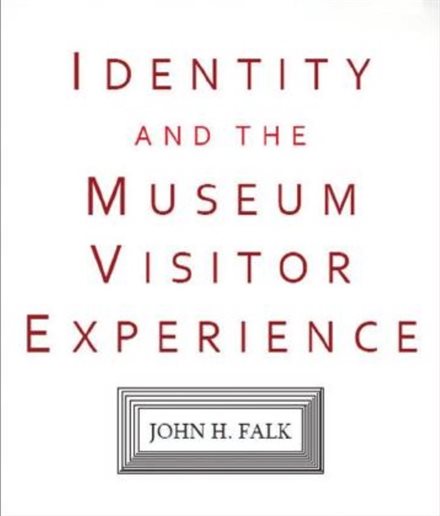
Published 2009/2016 by Routledge
In his book entitled Identity and the Museum Visitor Experience (2009/2016), John H. Falk - an Emeritus Professor of Free-choice Learning at Oregon State University in the USA - categorised museum visitors based on their motivations as follows:
- Explorers (those who find that ideas and objects that pique their curiosity generate high affect);
- Facilitators (those that look for their social group to be enjoying themselves - with enjoyment here constituting what the group finds exciting and memorable);
- Experience seekers (those that are attuned to seeing what they intended to see - something from which they derive a real high);
- Professional/hobbyists (those that find accomplishment of their personal goals quite satisfying such as looking for new ideas and inspiration and experimenting with these away from the museum);
- Rechargers (those in search of peace and psychological uplift which, if found, creates a sensation of great pleasure that remains memorable (Falk, 2009/2016: 176).
The key point here is that it is vitally important for CuL staff teams to internalise the motivations behind why people visit and use CuL’s assets and sites in the way they do in ‘the now’.
Doing so enables staff teams to ‘tailor-make’ offerings and provision in ‘the future’ in ways that effectively and productively shape how such offerings and provision are experienced positively by users.
Understanding a ‘data strategy’ as a useful tool to think with and generate actionable insights
The incredibly illuminating reflections shared, and (small-group and plenary) discussion held up to that point segued into the next task which asked two questions, namely (1) what does success look like? And (2) once the big problems are solved, what does life look like?
 Heritage Staff Team sharing their small-group discussion points during the third plenary session
Heritage Staff Team sharing their small-group discussion points during the third plenary session
Following small-group discussion, shared perceptions of what success looks like included:
- the creation of sustainable services and sustained validation of the quality of those services;
- improved literacy, health, and general wellbeing;
- more connected and empowered communities;
- more proactiveness on the part of local communities to partner with CuL teams;
- adding meaning to people’s lives;
- a greater ability to adapt to changing circumstances;
- more willingness for LCC as a whole to take risks and to earn a sustained, positive reputation; and
- supporting communities and places to become happier and healthier environments to live, work, and visit.
Much of this mirrored what life would look like when the big problems are solved:
- improved resilience;
- healthier and more connected communities;
- more services in new builds;
- less competition for tight budgets and public funds; and
- wider roll-out and uptake of smart services.
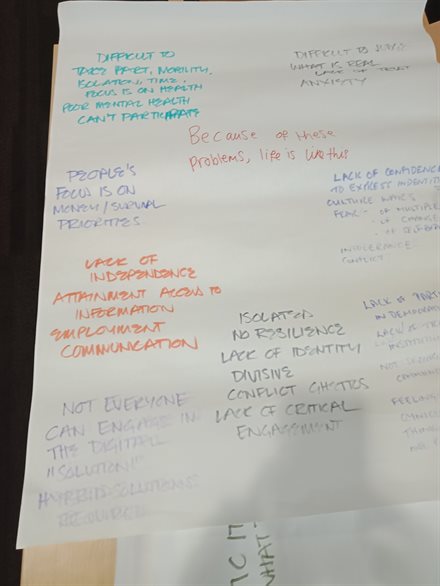 Flipchart paper capturing some of the ideas brainstormed and shared during the course of the day
Flipchart paper capturing some of the ideas brainstormed and shared during the course of the day
In reflecting on what needed to happen to achieve success after the big problems had been solved, several interesting observations were shared:
- It is critical to think about how best to use data to generate actionable insights and inform staff thinking;
- It is important to reflect on how best to use data to tell a story;
- It is vital to craft milestones that work for everyone in a cross-departmental context;
- It is crucial to bear in mind what data exists at any given time, and what gaps might be present in those data;
- It is key to learn to collect data without bias and to read those data correctly to understand what they might mean.
 Cultural Participation Staff Team sharing their small-group discussion points during the third plenary session
Cultural Participation Staff Team sharing their small-group discussion points during the third plenary session
These observations led us to the discussion of what a data strategy is. The definition that Beckie provided stated that a data strategy is ‘[a] long-term plan that defines the technology, processes, people, and rules required to manage an organisation's information assets’.
In other words, it helps the organisation identify big data questions to which data provide not only the answers sought, but also determine the most appropriate mechanisms for capture and processing.
It was reassuring to hear how this aligned very well with some of the central insights we learnt during the Visioning an Audience Data Strategy: A Symposium of Creative Approaches.
Asking qualitative and quantitative questions to generate operational and audience engagement insights relating to ‘the now’ and ‘the future’
This was followed by the last task which asked two questions. First, '[i]f you could ask any questions about your team, your work, your organisation, what would they be?' Second, '[g]roup your questions by theme. What themes might you use?' As explained above, there were multiple service strands of CuL’s work present at the workshop: Libraries, Museums, Cultural Participation, Collections and Creative Learning Services, and the Record Office. Despite their different foci, it was liberating to see how similar the questions of each service strand were, and how quick and easy ‘theming’ each question became.
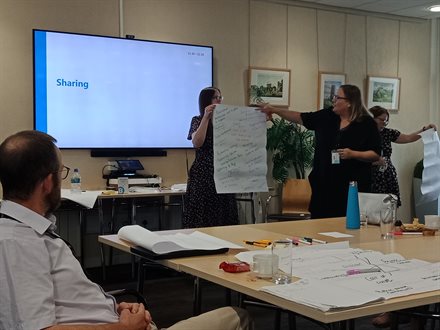 Libraries Staff Team sharing their small-group discussion points during the third plenary session
Libraries Staff Team sharing their small-group discussion points during the third plenary session
For example, some qualitative questions posed included the following:
- ‘What encourages you or motivates you into engaging with us?’
- ‘What stops you from engaging with us?’
- ‘What value do you experience from engaging with us?’
For example, some qualitative questions posed included the following:
- ‘What encourages you or motivates you into engaging with us?’
- ‘What stops you from engaging with us?’
- ‘What value do you experience from engaging with us?’
These questions were then quantified using further questions as follows:
- ‘How often do you attend?’
- ‘How many people are taking advantage of ticket offers?’
- ‘Are we reaching people who are often under-represented?’
Following the exercise of asking both qualitative and quantitative questions, further questions relating to organisational practice started to emerge. For instance:
- ‘What training do we need in order to get better?’
- ‘How can we make our work more efficient?’
- ‘How can we implement the learning from our research to improve what we do?’
Crafting a data-led approach to understanding and supporting local communities and to decision-making and service delivery
Once all the questions had been shared by staff teams, it became clear just how all service strands were aligned. Towards the end of the session, this was evidenced by comments such as ‘[m]any of our questions are already on the board’. Beckie skilfully arranged the questions by theme - linking directly back to the very themes that were identified as the key ‘mechanisms of change’ for CuL. Beckie used the questions asked by staff teams to provide valuable insight into those ‘mechanisms of change’.
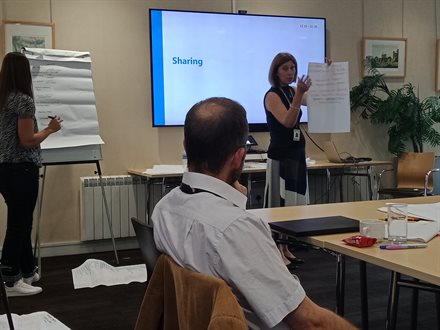 Franne sharing small-group discussion points on behalf of the Collections and Creative Learning Services as well as the Record Office Staff Teams during the third plenary session
Franne sharing small-group discussion points on behalf of the Collections and Creative Learning Services as well as the Record Office Staff Teams during the third plenary session
For example, the following selected questions link directly to the ‘mechanism of change’ in relation to building understanding and support in the local communities and neighbourhoods that CuL serves:
- ‘Are there people here who are not like you?’
- ‘Who are we engaging with?’
- ‘How can we reach those who we are not reaching?’
- ‘Is our work important [enough] to be happening here’
Further questions that link directly to the adoption of a data-led approach to decision-making and service delivery include:
- ‘What data do we need to collect?’
- ‘How do we feed data into decisions?’
- ‘Who is benefiting from our learning?’
- ‘What learning do our partners want to hear about?’
Towards developing a bespoke ‘Theory of Change’ model for Culture Leicestershire
Several other questions related to the ‘mechanism of change’ of CuL’s services becoming welcoming to everyone - and people feeling ‘well-served’:
- ‘What other services do people use?’
- ‘How can we make our spaces more accessible?’
- ‘How would you rate our experience overall?’
- ‘While you were here, were there other people similar to you?’
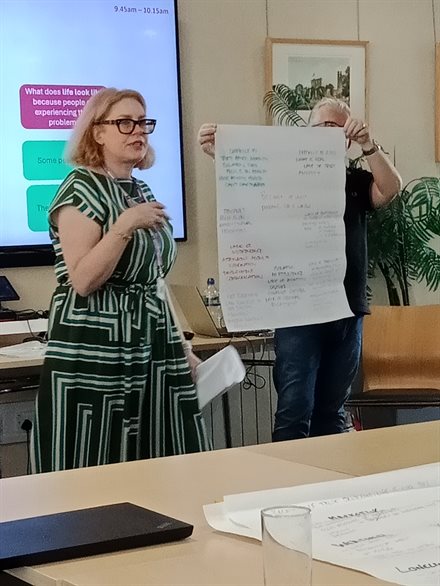 Collections and Creative Learning Services Staff Team sharing their small-group discussion points earlier during the day
Collections and Creative Learning Services Staff Team sharing their small-group discussion points earlier during the day
Beckie thoughtfully drew the day to a close by summarising some of the central and recurring learning points:
- It is through the process of identifying the key challenges that local communities face that CuL staff teams derive their objectives in delivering services that aimed at reducing those challenges;
- It is through the process of identifying the ‘mechanism of change’ that CuL service strands derive their intended outcomes;
- It is through the process of identifying ‘what you can do’ to solve the challenges that the outputs of CuL’s service strands are confirmed; and
- It is through the process of identifying the key questions that need to be asked that CuL staff teams can utilise those questions in evaluation and community consultation to demonstrate whether or not set outcomes have been achieved, and if not - identify what can be done to improve service offerings.
These learning points can be applied by any organisation undertaking a journey informed by the ‘theory of change’. Beckie explained that following the workshop, she would undertake a period of desk work to finesse the discussions of the day to develop a draft, bespoke ‘Theory of Change’ model for CuL.
At the time of writing, the model is currently in the edit and review stage with the Data Strategy Working Group. When ready, it is likely to be shared publicly.
Reference
Falk, John H. (2009/2016). Identity and the Museum Visitor Experience. London: Routledge